Abstract
Pigeons were exposed to seven types of two-component schedules, each component a 2-min fixed-interval schedule. Food presentation occurred at the completion of the second component under all conditions. The seven types of schedules were: (1) a chained schedule in which completion of the first component produced the discriminative stimulus associated with the second component; (2) a chained schedule to which was added the brief presentation of a food-paired stimulus at the completion of the first component; (3) a chained schedule to which was added the brief presentation of a stimulus not paired with food at the completion of the first component; (4) a multiple schedule in which food presentation occurred at the completion of both components; (5) a tandem schedule in which completion of the first component initiated the second component, with no changes in exteroceptive stimuli; (6) a food-paired brief-stimulus schedule in which the brief presentation of a food-paired stimulus was made at the completion of the first component and no other changes in stimuli occurred; and (7) a brief-stimulus schedule in which the brief presentation of a stimulus not paired with food was made at the completion of the first component and no other changes in stimuli occurred. Positively accelerated patterns of responding developed in the first component under three conditions: (1) the chained schedule with the added food-paired brief stimulus; (2) the multiple schedule; and (3) the food-paired brief-stimulus schedule. Response rates were low in the first component, with few instances of positively accelerated patterns, under two conditions: (1) the chained schedule; and (2) the chained schedule with the added nonpaired brief stimulus. The results suggest that a briefly presented food-paired stimulus may function as a more effective conditioned reinforcer than does the presentation of a discriminative stimulus.
Full text
PDF




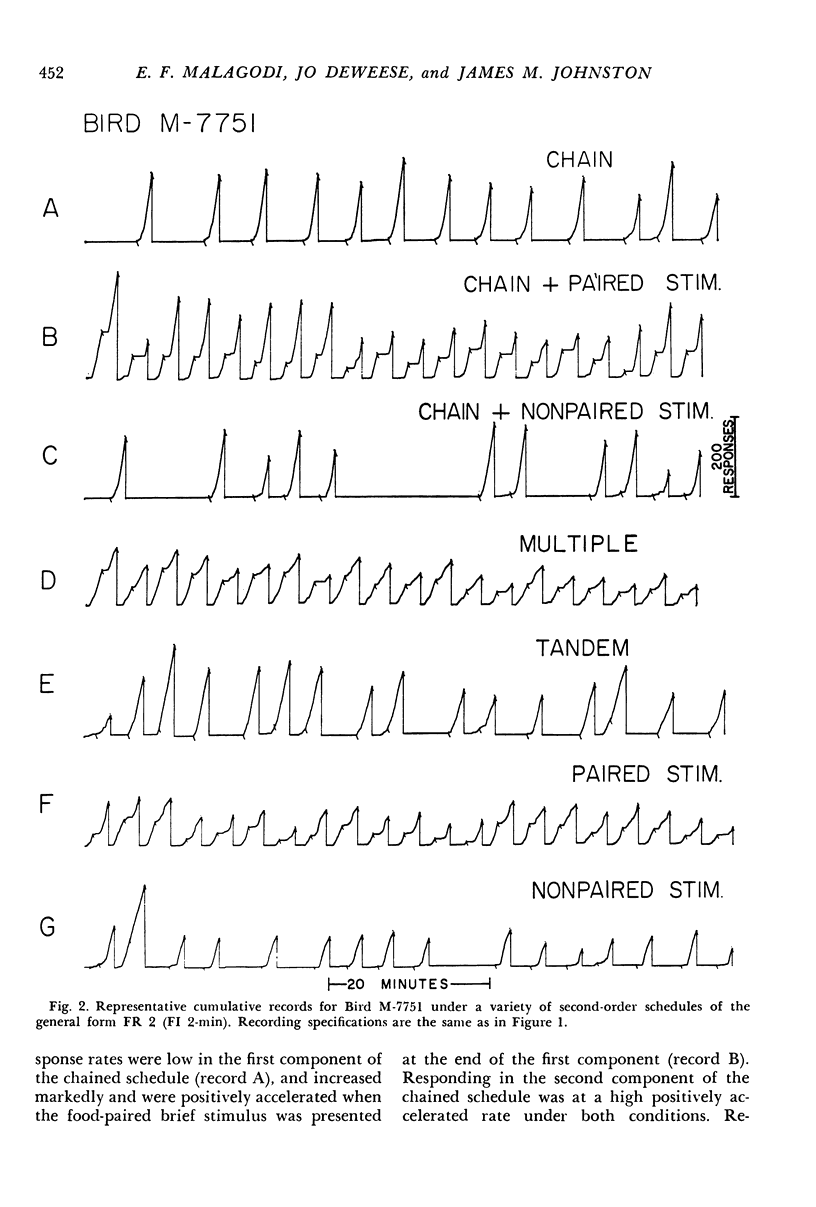
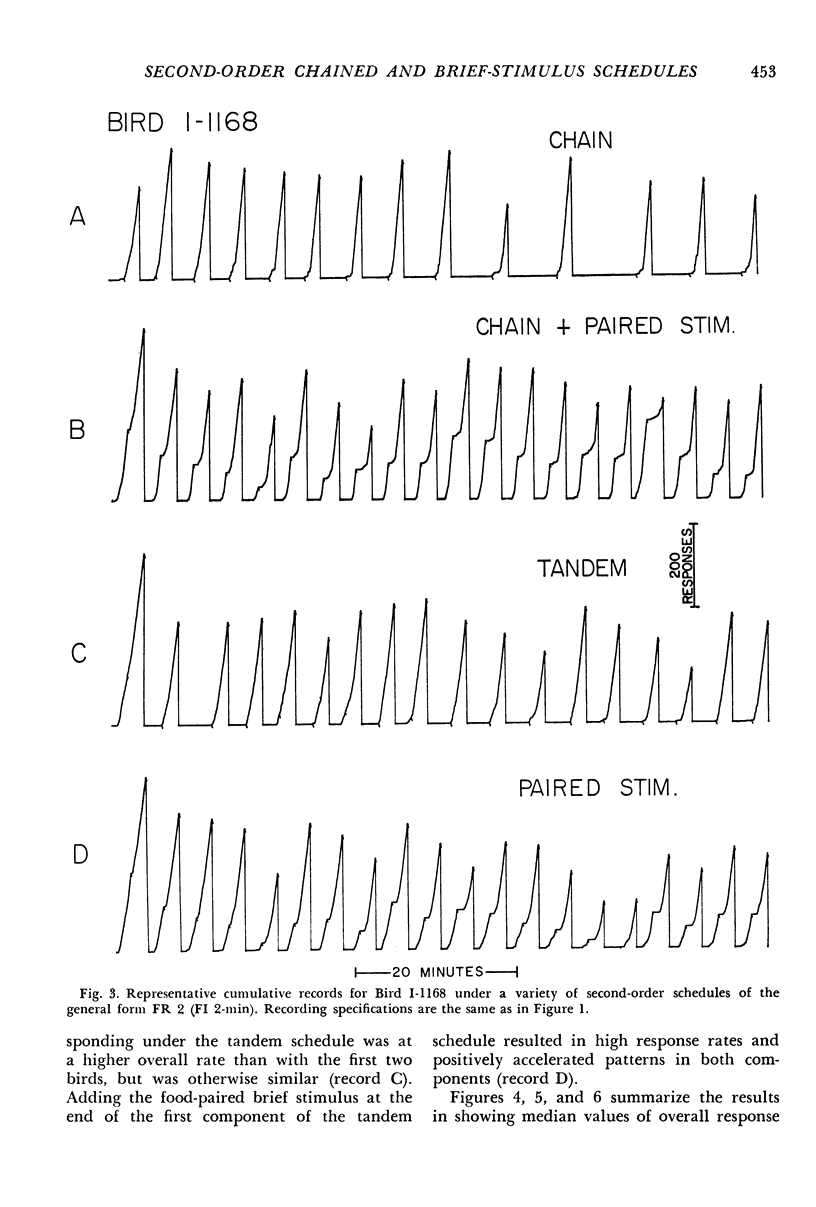


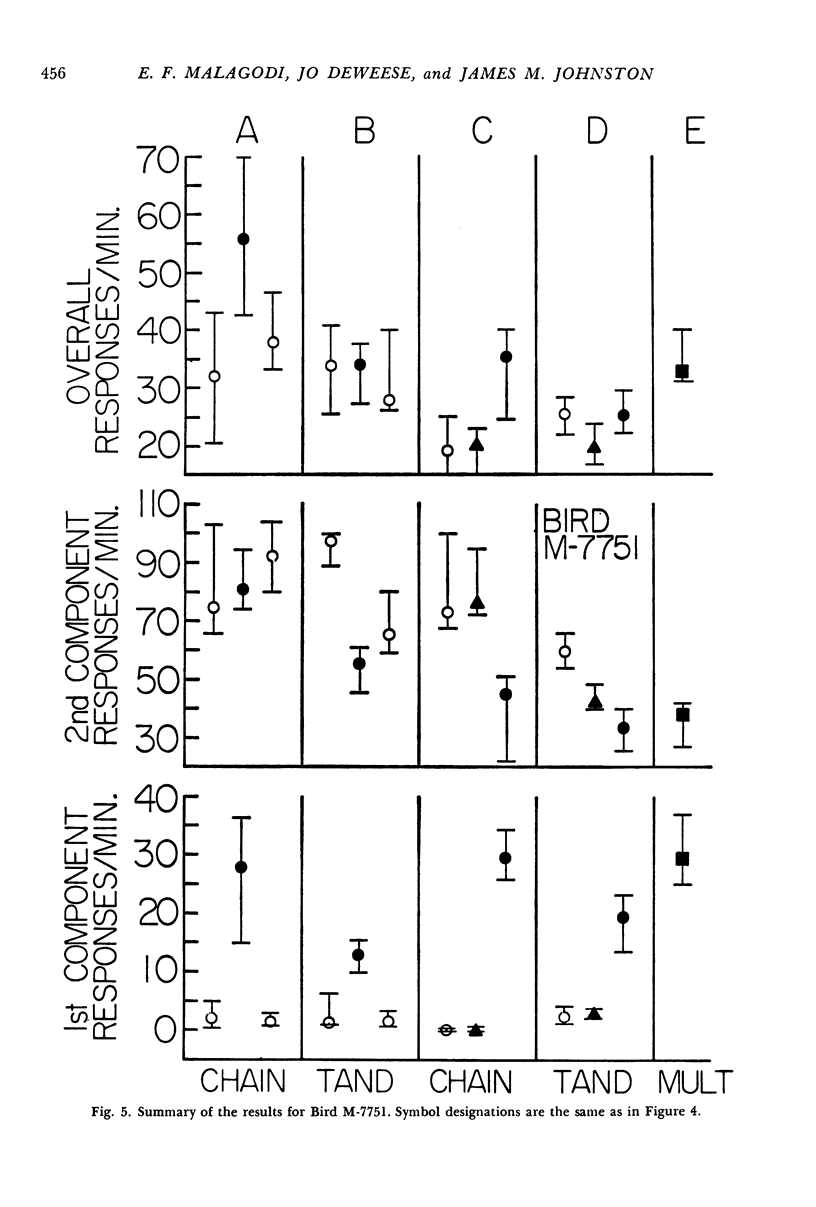

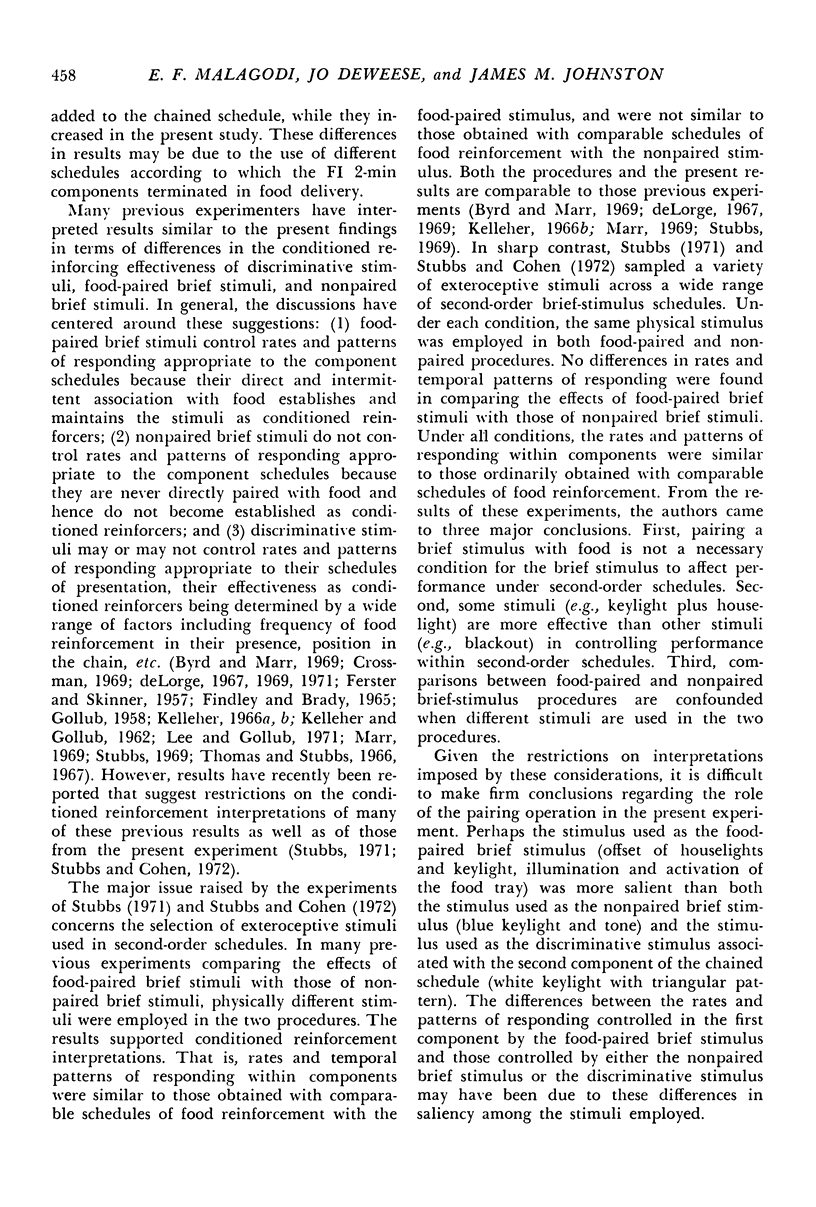
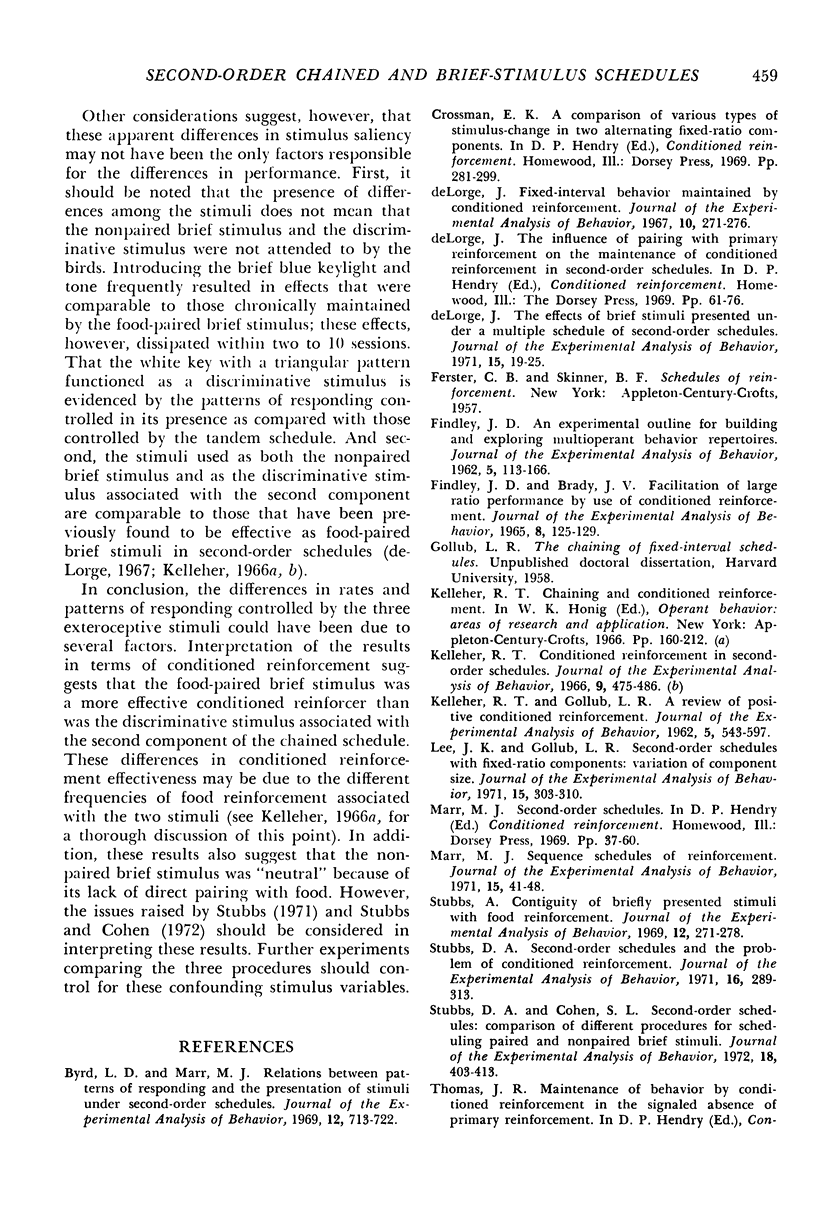

Selected References
These references are in PubMed. This may not be the complete list of references from this article.
- Byrd L. D., Marr M. J. Relations between patterns of responding and the presentation of stimuli under second-order schedules. J Exp Anal Behav. 1969 Sep;12(5):713–722. doi: 10.1901/jeab.1969.12-713. [DOI] [PMC free article] [PubMed] [Google Scholar]
- De Lorge J. Fixed-interval behavior maintained by conditioned reinforcement. J Exp Anal Behav. 1967 May;10(3):271–276. doi: 10.1901/jeab.1967.10-271. [DOI] [PMC free article] [PubMed] [Google Scholar]
- De Lorge J. The effects of brief stimuli presented under a multiple schedule of second-order schedules. J Exp Anal Behav. 1971 Jan;15(1):19–25. doi: 10.1901/jeab.1971.15-19. [DOI] [PMC free article] [PubMed] [Google Scholar]
- FINDLEY J. D. An experimental outline for building and exploring multi-operant behavior repertoires. J Exp Anal Behav. 1962 Jan;5(Suppl):113–166. doi: 10.1901/jeab.1962.5-s113. [DOI] [PMC free article] [PubMed] [Google Scholar]
- FINDLEY J. D., BRADY J. V. FACILITATION OF LARGE RATIO PERFORMANCE BY USE OF CONDITIONED REINFORCEMENT. J Exp Anal Behav. 1965 Mar;8:125–129. doi: 10.1901/jeab.1965.8-125. [DOI] [PMC free article] [PubMed] [Google Scholar]
- KELLEHER R. T., GOLLUB L. R. A review of positive conditioned reinforcement. J Exp Anal Behav. 1962 Oct;5:543–597. doi: 10.1901/jeab.1962.5-s543. [DOI] [PMC free article] [PubMed] [Google Scholar]
- Lee J. K., Gollub L. R. Second-order schedules with fixed-ratio components: variation of component size. J Exp Anal Behav. 1971 May;15(3):303–310. doi: 10.1901/jeab.1971.15-303. [DOI] [PMC free article] [PubMed] [Google Scholar]
- Stubbs A. Contiguity of briefly presented stimuli with food reinforcement. J Exp Anal Behav. 1969 Mar;12(2):271–278. doi: 10.1901/jeab.1969.12-271. [DOI] [PMC free article] [PubMed] [Google Scholar]
- Stubbs D. A., Cohen S. L. Second-order schedules: comparison of different procedures for scheduling paired and nonpaired brief stimuli. J Exp Anal Behav. 1972 Nov;18(3):403–413. doi: 10.1901/jeab.1972.18-403. [DOI] [PMC free article] [PubMed] [Google Scholar]
- Stubbs D. A. Second-order schedules and the problem of conditioned reinforcement. J Exp Anal Behav. 1971 Nov;16(3):289–313. doi: 10.1901/jeab.1971.16-289. [DOI] [PMC free article] [PubMed] [Google Scholar]
- Thomas J. R., Stubbs A. Stimulus control of temporally spaced responding in second-order schedules. J Exp Anal Behav. 1967 Mar;10(2):175–183. doi: 10.1901/jeab.1967.10-175. [DOI] [PMC free article] [PubMed] [Google Scholar]
- ZIMMERMAN J. TECHNIQUE FOR SUSTAINING BEHAVIOR WITH CONDITIONED REINFORCEMENT. Science. 1963 Nov 8;142(3593):682–684. doi: 10.1126/science.142.3593.682. [DOI] [PubMed] [Google Scholar]


